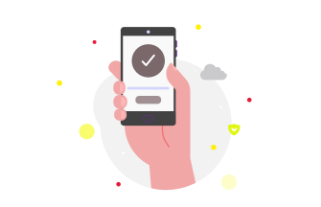A fixed deposit is one of the most traditional and popular investment plans in India. Many people invest a sizeable portion of their income in a fixed deposit or FD plan. If you are just starting your investment and saving journey, it would be best to invest a significant portion of the amount in FD as it is considered the safest and risk-free investment option.
Investing in FD is an excellent long-term investment option that allows you to grow your money faster than just keeping it ideal in a savings bank account. So, if you have any surplus funds, you can invest in FD and accumulate wealth for your future goals.
Invest Smartly with Mahindra Finance!
Now that you know the FD full form, let us know more about what is deposit account and how does it work?
What is a fixed deposit account?
A fixed deposit is a term deposit investment plan in which you invest a lumpsum amount for a fixed period. You can decide the investment tenure at the time of investment, and it can range from 12 months to 60 months.
During the investment tenure you choose, you get an assured return in the form of an interest rate, which is fixed at the time of deposit and remains the same throughout the tenure. The returns or the interest are credited at a fixed interval as you choose, such as monthly, quarterly, bi-annually, or annually.
This means the longer you stay invested, the better your chances of getting higher returns.
How does the fixed deposit work?
Now that you know what a fixed deposit account is, it would help to know how it works. To invest in a fixed deposit, you must open a fixed deposit account with the financial institution. Different banks and NBFCs (non-banking financial companies) may have different requirements and processes for opening an FD account, but it is generally quite simple.
You just have to submit an application form and deposit the money you want in cash by issuing a cheque or DD (demand draft) or issuing a standing instruction to the bank to debit your account with a specific amount towards FD.
One of the most important features of fixed deposit account is that it comes with a lock-in period. This means that once you deposit the money in an FD account, you cannot withdraw it until the end of the investment period you choose. This can be a great boon for you since it deters you from liquidating the funds, and at the end of the tenure, you get a lump sum amount.
Types of FD account
FD accounts can be broadly categorised into two types based on the interest payout method: cumulative fixed deposit accounts and non-cumulating fixed deposit accounts. Let us know more about the types of FD accounts.
Cumulative fixed deposit
A cumulative fixed deposit is a type of FD account where the interest accrued on your investment amount is paid to you at the time of maturity, i.e., at the end of the investment tenure. The interest amount is compounded quarterly or yearly as per the agreed terms and conditions.
This means that as an investor, you earn interest on the principal amount and on the interest earned in the preceding period. The compounded interest is added to the principal amount until maturity, and you get a lump sum amount at the end of the tenure.
Let us understand how a cumulative fixed deposit account works with an example –
Let us assume Miss Shruti Pathak invests Rs. 10 Lakh in a 5-year cumulative FD account, and the financial institution pays an interest of 6% per annum, compounded annually.
The table below shows how compounding interest works and Miss Pathak’s earnings at the end of each year.
| Investment Year | Opening Balance | The Interest Amount Earned (@ 6%) | Closing Balance |
| 1 | 10,00,000 | 60,000 | 10,60,000 |
| 2 | 10,60,000 | 63,600 | 11,23,600 |
| 3 | 11,23,600 | 67,416 | 11,91,016 |
| 4 | 11,91,016 | 71,461 | 12,62,477 |
| 5 | 12,62,477 | 75,749 | 13,38,266 |
So, from the above table, it is quite evident that the interest earned in the first year of the investment tenure is added to the principal amount at the start of the subsequent year. The investor then earns interest on this additional amount, too, therefore getting additional interest.
The total interest earned during five years is Rs. 3,38,226/- and the maturity amount that Miss. Pathak gets is Rs. 13,38,226. However, Miss. Pathak may have to pay a tax on the interest earned as per the regular tax bracket.
A cumulative fixed deposit account is an excellent investment option for you if you are not dependent on the interest earned to meet your regular expenses.
Non-Cumulative Fixed Deposit
In a non-cumulative fixed deposit account, the interest earned on your deposit is paid to you on a monthly, quarterly, half-yearly or annually as per the interest payout period you choose. In non-cumulative fixed deposits, the amount meant to be paid at maturity keeps declining as the interest is paid on a regular basis. Also, the interest paid is taxable, and you must pay the taxes as per your existing tax bracket.
Let us understand the workings of a non-cumulative fixed deposit account with an example. Miss. Shruti Pathak opens a non-cumulative fixed deposit account and invests Rs. 10 Lakh for five years at a 6% annual interest rate.
Since it is a non-cumulative FD account, Miss. Pathak will be entitled to receive the interest on her deposit at a predetermined frequency. However, since she receives the interest periodically, she would lose out on the benefit of compounded interest year after year.
The table below shows the interest calculation for a non-cumulative fixed deposit.
| Investment Year | Opening Balance | The Interest Amount Earned (@ 6%) | Closing Balance |
| 1 | 10,00,000 | 60,000 | 10,60,000 |
| 2 | 10,00,000 | 60,000 | 10,60,000 |
| 3 | 10,00,000 | 60,000 | 10,60,000 |
| 4 | 10,00,000 | 60,000 | 10,60,000 |
| 5 | 10,00,000 | 60,000 | 10,60,000 |
Investing in a non-cumulative FD account is an excellent investment option if you don’t have a regular income source. You can take care of your regular expenses through the interest earned on the FD investment; it will give you a regular income stream.
Additional read: Difference Between Cumulative and Non-Cumulative FD
Final Word
Fixed deposit is an excellent investment option for conservative investors who are just starting their investment journey or do not wish to take any risk. You can invest in cumulative or non-cumulative FDs according to your requirements and financial situation and be assured of valuable returns.
Make sure that you invest in FD with a credible and reputed financial organisation like Mahindra Finance, which offers a high interest rate of 8.10% per annum. And if you are a senior citizen, i.e., aged more than 60, you get 0.25% additional interest.
Also, you get the flexibility to choose the investment tenure, ranging from 12 to 60 months. Lastly, the easy online application process makes the investment process easy and hassle-free.

























































